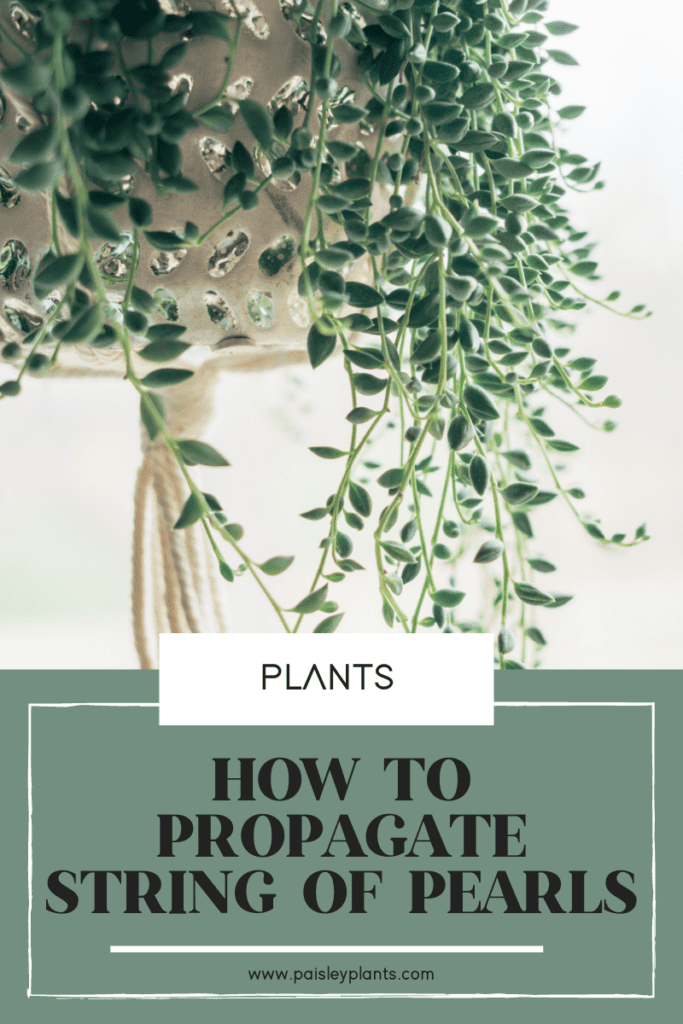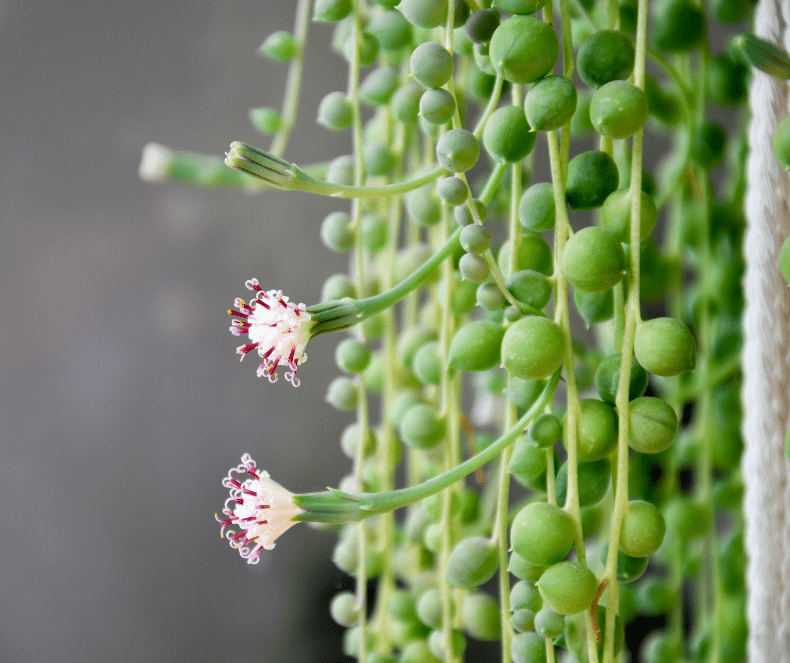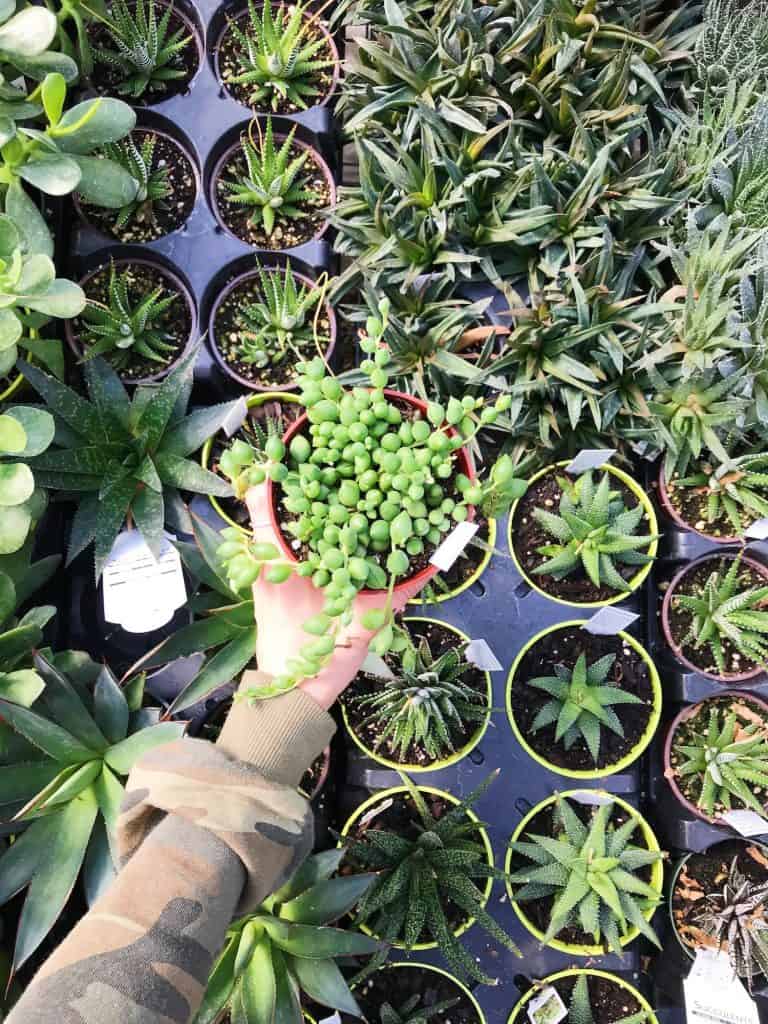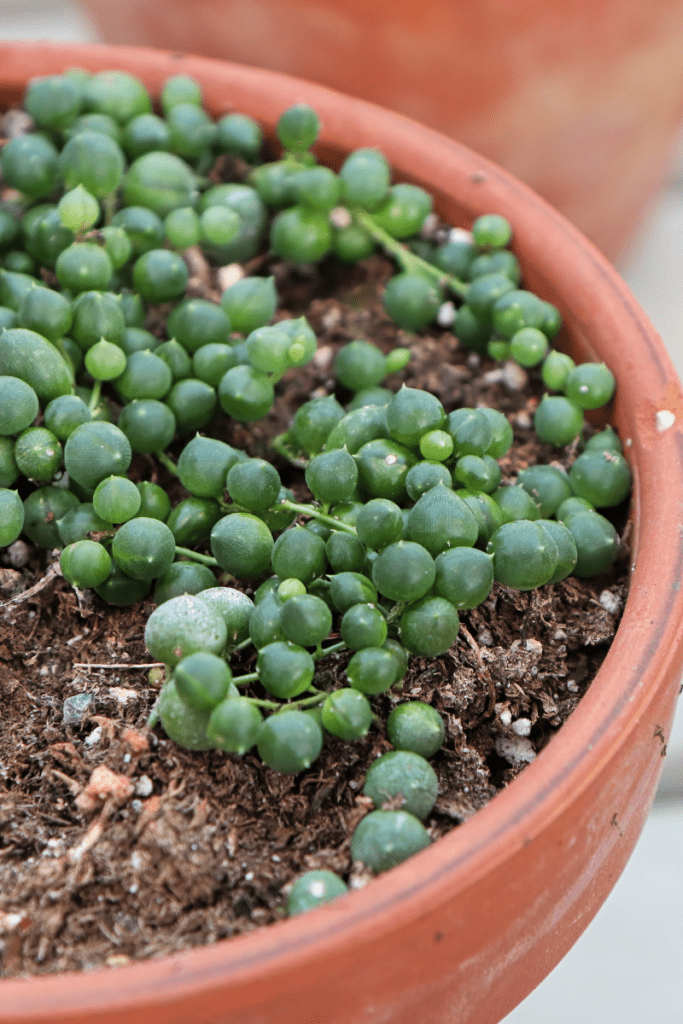Iconic, low-maintenance, and oh-so adorable: the string of pearls is a popular succulent amongst gardeners of all skillsets.
My favorite part of the string of pearls plants is how easy it is to multiply! With these simple tips and instructions, you’ll be successfully propagating string of pearl plants for generations!

This post includes affiliate links.
Table of Contents
Background Information
Native to South Africa, the string of pearls (Curio rowleyanus formally Senecio rowleyanus) is one of the most identifiable varieties of succulent plants out there! This plants common names are both string of pearls and string of beads.
These vining succulents are best known for their unique appearance. Staying true to their name, the string of pearls plant has tiny spherical leaves that grow from a thin string-like vine. The string of pearls is a rapid grower; reaching 1 to 2 feet long at full maturity.
You’ll often see this plant as ground cover or in a hanging basket. Both are
With very meticulous care, the string of pearls is capable of producing flowers. Blooming in the summer, string of pearl flowers are white in color and are described as having a cinnamon scent.

Unfortunately, the string of pearls is toxic to both pets and humans. If you live with pets or small children, please exercise extreme caution if you choose to keep this plant in the household.
Are String of Pearls Hard to Propagate?
Not at all! In fact, the string of pearls is one of the easier plants to propagate via stem cuttings. Let’s take a look at some methods to propagate the string of pearls.
Propagation Methods
Water Propagation
Water propagation is the process of rooting your string of pearls cuttings in a vessel of water or propagation station. This method of propagation is very straightforward and is the easiest way to propagate your plant.
Tools Needed:
- A mature, healthy string of pearls plant
- A small container of water or propagation station
- Sterile pruning shears
Steps:
- Take a healthy stem cutting from your plant just below the leaf node. The stem should be around 4 to 5 inches in length
- Remove the bottom 2 leaves from the stem, exposing the nodes.
- Fill a small container or propagation station with water.
- Place the stem cuttings in the water, ensuring the node is fully under the water.
- Place the plant pot in a location with bright, indirect light.
- It takes about 3 to 4 weeks for the plant to produce new roots which you will see through the water!
- Once they have roots that are an inch or two long, you can pot them in soil
Pros:
- Easy and fast way to propagate your plant; your plant should get roots within a month.
- Minimal tools needed to successfully propagate, all you need is your plant, a container of water, and a pair of shears
Cons:
It has one extra step than soil propagation. After the plant has new roots you’ll need to put it in a new pot with soil.
Soil Propagation

Soil propagation is the process of rooting your string of pearls cuttings in a pot of soil. If you don’t want to mess with water propagation, this is a great option.
Tools Needed:
- A mature, healthy string of pearls plant
- Plant pot with soil
- Sterile pruning shears
Steps:
- Take a healthy stem cutting from your plant just below the leaf node. The stem should be around 4 to 5 inches in length
- Remove the bottom 2 leaves from the stem, exposing the nodes.
- Lay the cut end out and allow for it to dry for about 1 to 2 days. The cut-end of the stem must callous over.
- Fill a small pot with the appropriate soil. Use your finger to dig a small hole in the top of the soil about 1 inch deep; this is where you will bury your plant stem.
- Bury the cut-end of the stem into the soil, making sure all leaves are above the soil.
- Wait a few days before wetting your soil. When the time comes, make sure the soil is lightly moistened. Moisten the soil when the it has dried up.
- Place the plant pot in a location with bright, indirect light.
- It can take quite a long time for the plant to produce new roots and become established. If you want to check if your stem has rooted, try giving it a gentle tug. If there’s any resistance, then that means your stem has propagated successfully.
Pros:
- Easy and fast way to propagate your plant; your plant should establish within a month.
- Minimal tools needed to successfully propagate, all you need is your plant, a pot, and a pair of shears
Cons:
- You can’t see the roots growing under the soil; therefore, you won’t know that the propagation was successful for a month.
Collecting Seeds

This method is not recommended, but it is worth mentioning. Propagating string of pearl plants from seed is extremely difficult, time consuming, and there is a good chance the seeds might not work.
String of pearl seeds come from the flower, which only blooms in the summer under the right conditions. Very seldom do these plants bloom when grown indoors. In order to produce viable seeds, these flowers must be pollinated. As a result, there is no certainty a seed is viable until it is planted.
Another reason growing string of pearls from seed is not recommended is the time it takes to germinate seeds. String of pearl seeds have an unpredictable rate of germination, ranging from a 3 weeks to 3 months. Propagating your string of pearls via stem cuttings is much more preferable to starting from seed.
String of Pearls Care After Propagation
Sunlight
The string of pearls ideally thrive on an alternating combo of direct and indirect sunlight; the total of which should be about 6 to 8 hours a day. They grow well when exposed to direct morning sunlight, and indirect afternoon sunlight.
Therefore, it might benefit your plant greatly if you placed your string of pearls in an East-facing window.
If your plant isn’t getting enough light, it might be worth getting a grow light to help it get the light it needs.
Water
During the peak growing season (spring and summer), make sure your string of pearls’ soil is lightly moist. During the winter when your plant is dormant, reduce the watering.
If your plant’s leaves start to flatten, this is a sign that the plant needs more water. On average, a string of pearls needs to be watered once every 14 days. However, if you live in a hot climate, growing your plant outdoors in the summer, or in a terra cotta pot, you might find yourself watering your plant more often.
Always be sure your pot has good drainage so excess water doesn’t sit in the bottom of the pot.

Soil
The string of pearls will grow well in a cactus mix or succulent mix, though ideally they grow best in a sandy soil. These plants are sensitive to too much water and are prone to root rot, so the most important part of selecting a soil is drainage. String of pearls enjoy a soil pH that is neutral to acidic.
Fertilizer
To promote vigorous growth, fertilize your string of pearls every two weeks during its growing season. Select a liquid fertilizer with a balanced NPK ratio that is diluted to half its strength.
During the winter dormancy, cut down your fertilizer routine to only once every six weeks.
Temperature & Humidity
The string of pearls thrive in warm temperatures. During the spring, summer, and fall the ideal temperature average for this plant is roughly 70° F. During the winter months, the temperature should get slightly cooler, around 50° to 60° F.
This plant prefers drier conditions. Try to avoid keeping it in a location that is high in humidity such as a kitchen or bathroom.
Choosing a Container & Repotting
Selecting a plant container with ample drainage is essential to the longevity of your string of pearls. As we’ve discussed previously, the string of pearls enjoys a slightly moist soil, and housing your plant in a container with drainage holes is key to maintaining a proper level of soil moisture. The string of pearls plant has shallow roots so a large pot isn’t necessary for this plant.
The best time to repot your plant is during the springtime. Size up your plant very gradually, only a couple inches larger than the previous pot. Start repotting by adding a layer of soil at the bottom of the pot and then place the plant at the center of the pot. Fill out the rest of the pot, surrounding the root ball with soil.
You can repot a string of pearls once a year, though this can only be done a couple times as this particular plant will start to die back after a few years. It’s best to propagate a new plant from your string of pearls while it’s still young and healthy rather than repot a plant that will die within a few years.
Pruning
Pruning your plant is an excellent way to encourage fuller, bushier growth in your string of pearls. It’s always a good idea to trim any dead or damaged foliage, as this will redirect your plant’s energy towards developing new, healthy growth.
If your plant is looking a bit leggy and sparse, don’t be afraid to trim those vines back. You can use healthy vine trimmings to propagate new plants!
Frequently Asked Questions
The string of pearls is a relatively short-lived plants compared to other perennials. After about 3 to 5 years, they will start to die back and wither.
However, this is all the more reason to propagate your plant while it is still young and healthy. By propagating your plant, you’re making a new copy of your old string of pearls- so your plant can live on indefinitely!
This sounds like a sign of root rot. Root rot is the result of overwatered soil, which invites fungus and causes the roots to break down from the excessive moisture.
Root rot can be extremely deadly to your plant. To save the plant in this situation, you can allow the soil to dry out and see if the issue remedies on its own. Unfortunately, if it is too late, the best you can do is try and salvage any healthy stems and propagate them.
Root rot is a fungal disease, so make sure any affected soil and plants are disposed of entirely. Make sure to sterilize your plant’s pot before replanting anything.
This is often the result of an insect infestation. While pests are a nuisance, they can be easily treated by applying neem oil to your plant, which is a natural and effective pest control.
In Conclusion
What should you do with all these new plants you’ve grown via propagating? I suggest spreading the love! Propagated plants make perfect gifts for friends and family.
It’s amazing how one little succulent can create so many plants just by snipping off a piece of their vines. When done correctly, propagating plants is easy, satisfying, and you’ll want to try it over and over again.

